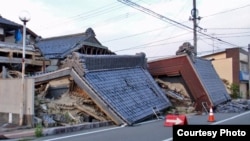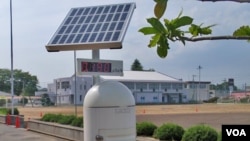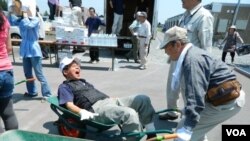Few people would voluntarily move to a place where residents routinely scan their groceries with a Geiger counter and automated radiation monitors stand guard outside parks and schools.
That place is Minamisoma, Japan, a city 25 kilometers away from the Fukushima-Daiichi nuclear reactors which melted down last year.
But for Kate O'Berg, 23-year-old art instructor from Pendleton, Oregon, working in this shaken city has been the realization of a dream. The young American is helping people in her hometown's sister city to rebuild their lives.
Horses were the original connection that drew Minamisoma and Pendleton together as sister cities: samurai horsemanship in the coastal Japanese town and a famous rodeo - the Pendleton Round-Up - in northeast Oregon.
So when a desperate plea from the mayor of Minamisoma went viral on YouTube after last year's nuclear meltdown, the people of Pendleton heard the message loud and clear. Financial support followed, but it took a while for many volunteers to hazard a trip to this region on the border of the nuclear no-go zone.
O'Berg had been to Minamisoma years before as a high school exchange student. She went back again briefly last year to help with disaster cleanup. Then, right after Christmas, came a job offer from the city and school system of Minamisoma.
O'Berg had one day to decide if she wanted to leave her post with the Pendleton Center for the Arts and move to the Japanese disaster zone to teach English. She would also be the city's part-time cultural ambassador.
"I just lit up," O'Berg says. "I said, 'I'll come back. I'll teach here, I'll teach here. I don't have a degree, but I'll do it.'"
Growing up downriver from a U.S. Department of Energy nuclear facility, one of America's biggest radioactive waste cleanup projects, taught O'Berg about living with radiation risk and uncertainty.
She brought a hand-held Geiger counter to Japan and uses it to scan her groceries before putting them away in her apartment's tiny kitchen. Knowing the risks, O'Berg still opted to come to Japan.
"There definitely were considerations of my own health," she says. "My viewpoint on it is that a lot of people get cancer and just can't help it. But I'm doing what I want to do and I'm helping other people. People risk their lives all the time to help others."
O’Berg assesses her personal risk as minimal at this point. On a bike ride, she explains why she's so drawn to rural Japan.
There's traffic out and about, a sign that Minamisoma's population is gradually rebounding. More than 600 people drowned here in the tsunami of March 2011.
Afterwards, the majority of town residents temporarily evacuated to get farther away from the nuclear meltdown at the damaged Fukushima reactors nearby.
Passing the junior high school, O'Berg says half-empty classrooms are beginning to fill back up with students. The topsoil on the playing field was scraped off and replaced with clean dirt.
Meanwhile, thousands of local people are still living in crowded emergency housing blocs. O'Berg comes to a stop at a complex that resembles a self-storage facility, but with more windows.
On weekends, she regularly joins volunteers who deliver food and good cheer to these small prefab units.
"It's normally an elderly citizen who can't get to the store," she says. "We share our smiling faces and wheelbarrow the food to their home for them and bring it inside their house. It's definitely a really amazing feeling to help someone like that."
O'Berg is the only Oregonian living full-time in Minamisoma. A handful of other volunteers from Oregon, Washington and British Columbia make periodic visits to lend a hand with food distribution and tsunami cleanup.
"I'm told that I'm such a brave person for coming here," O'Berg says. "But it's something I wanted to do so I don't feel that I am any braver than someone living here."
Soon, the sister city link will go in the other direction. Six middle and high school students from Minamisoma will fly to Pendleton. Their two-week friendship visit is timed to coincide with the Pendleton Round-Up’s famous rodeo.
That place is Minamisoma, Japan, a city 25 kilometers away from the Fukushima-Daiichi nuclear reactors which melted down last year.
But for Kate O'Berg, 23-year-old art instructor from Pendleton, Oregon, working in this shaken city has been the realization of a dream. The young American is helping people in her hometown's sister city to rebuild their lives.
Horses were the original connection that drew Minamisoma and Pendleton together as sister cities: samurai horsemanship in the coastal Japanese town and a famous rodeo - the Pendleton Round-Up - in northeast Oregon.
So when a desperate plea from the mayor of Minamisoma went viral on YouTube after last year's nuclear meltdown, the people of Pendleton heard the message loud and clear. Financial support followed, but it took a while for many volunteers to hazard a trip to this region on the border of the nuclear no-go zone.
O'Berg had been to Minamisoma years before as a high school exchange student. She went back again briefly last year to help with disaster cleanup. Then, right after Christmas, came a job offer from the city and school system of Minamisoma.
O'Berg had one day to decide if she wanted to leave her post with the Pendleton Center for the Arts and move to the Japanese disaster zone to teach English. She would also be the city's part-time cultural ambassador.
"I just lit up," O'Berg says. "I said, 'I'll come back. I'll teach here, I'll teach here. I don't have a degree, but I'll do it.'"
Growing up downriver from a U.S. Department of Energy nuclear facility, one of America's biggest radioactive waste cleanup projects, taught O'Berg about living with radiation risk and uncertainty.
She brought a hand-held Geiger counter to Japan and uses it to scan her groceries before putting them away in her apartment's tiny kitchen. Knowing the risks, O'Berg still opted to come to Japan.
"There definitely were considerations of my own health," she says. "My viewpoint on it is that a lot of people get cancer and just can't help it. But I'm doing what I want to do and I'm helping other people. People risk their lives all the time to help others."
O’Berg assesses her personal risk as minimal at this point. On a bike ride, she explains why she's so drawn to rural Japan.
There's traffic out and about, a sign that Minamisoma's population is gradually rebounding. More than 600 people drowned here in the tsunami of March 2011.
Afterwards, the majority of town residents temporarily evacuated to get farther away from the nuclear meltdown at the damaged Fukushima reactors nearby.
Passing the junior high school, O'Berg says half-empty classrooms are beginning to fill back up with students. The topsoil on the playing field was scraped off and replaced with clean dirt.
Meanwhile, thousands of local people are still living in crowded emergency housing blocs. O'Berg comes to a stop at a complex that resembles a self-storage facility, but with more windows.
On weekends, she regularly joins volunteers who deliver food and good cheer to these small prefab units.
"It's normally an elderly citizen who can't get to the store," she says. "We share our smiling faces and wheelbarrow the food to their home for them and bring it inside their house. It's definitely a really amazing feeling to help someone like that."
O'Berg is the only Oregonian living full-time in Minamisoma. A handful of other volunteers from Oregon, Washington and British Columbia make periodic visits to lend a hand with food distribution and tsunami cleanup.
"I'm told that I'm such a brave person for coming here," O'Berg says. "But it's something I wanted to do so I don't feel that I am any braver than someone living here."
Soon, the sister city link will go in the other direction. Six middle and high school students from Minamisoma will fly to Pendleton. Their two-week friendship visit is timed to coincide with the Pendleton Round-Up’s famous rodeo.













